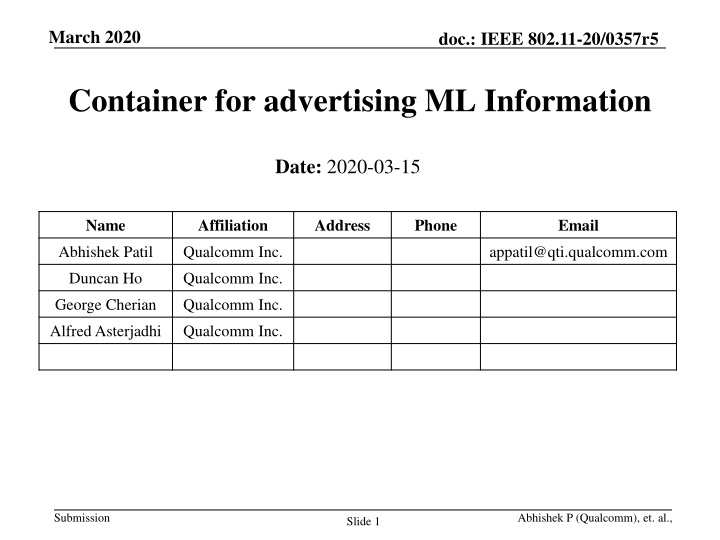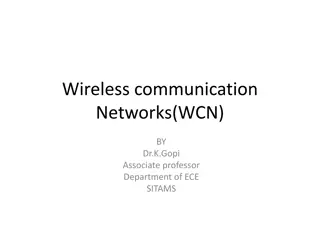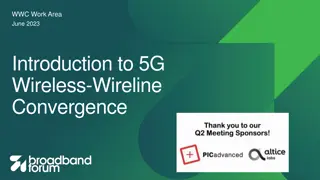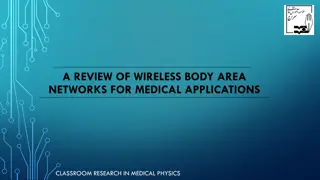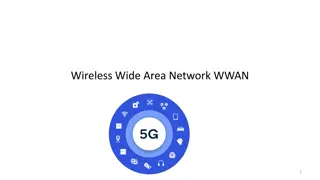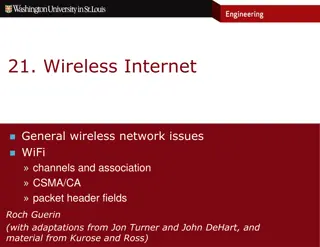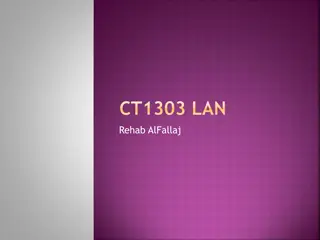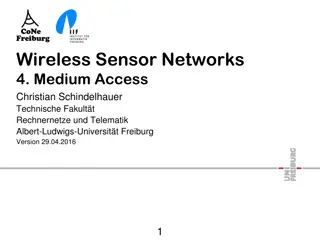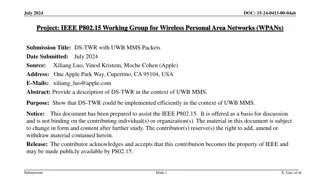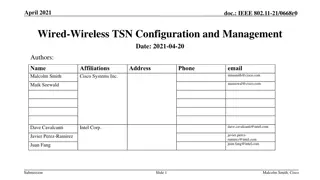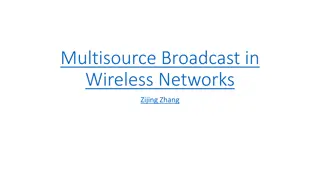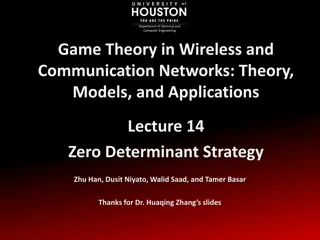Efficient Information Exchange for Wireless Networks
This document discusses the optimization of information exchange in IEEE 802.11 networks to reduce management frame overhead, improve power efficiency, and streamline the process of gathering and exchanging MLO information between APs and non-AP MLDs. The proposal suggests using beacon frames and directed ML probing mechanisms to enable efficient communication while minimizing unnecessary overhead.
Download Presentation

Please find below an Image/Link to download the presentation.
The content on the website is provided AS IS for your information and personal use only. It may not be sold, licensed, or shared on other websites without obtaining consent from the author.If you encounter any issues during the download, it is possible that the publisher has removed the file from their server.
You are allowed to download the files provided on this website for personal or commercial use, subject to the condition that they are used lawfully. All files are the property of their respective owners.
The content on the website is provided AS IS for your information and personal use only. It may not be sold, licensed, or shared on other websites without obtaining consent from the author.
E N D
Presentation Transcript
March 2020 doc.: IEEE 802.11-20/0357r5 Container for advertising ML Information Date: 2020-03-15 Name Affiliation Address Phone Email Abhishek Patil Qualcomm Inc. appatil@qti.qualcomm.com Duncan Ho Qualcomm Inc. George Cherian Qualcomm Inc. Alfred Asterjadhi Qualcomm Inc. Submission Abhishek P (Qualcomm), et. al., Slide 1
March 2020 doc.: IEEE 802.11-20/0357r5 Motivation A non-AP MLD should be able to gathers complete MLO information about an AP MLD with minimal mgmt. frame overhead Saves power by not requiring the non-AP MLD to enable multiple radios (i.e., scan other bands/channels of the AP MLD) Reduces discovery to ML setup time Reduced air-time occupancy of mgmt. frames Submission Slide 2 Abhishek P (Qualcomm), et. al.,
March 2020 doc.: IEEE 802.11-20/0357r5 Advertisement of MLO information Beacon frames are sent periodically and at lower MCS At any given instance, we don t expect to have several unassociated non-AP MLDs waiting for a beacon MLO information that doesn t get consumed can be considered as an overhead A scanning STA s broadcast probe request solicits responses from several APs in the neighborhood Unwise to pack too much information in a regular probe response Therefore, a beacon or a regular probe response should carry minimal information to prevent mgmt. frame overhead Proposal: Beacon/(regular) probe carries basic MLO information A directed ML probing mechanism to exchange complete MLO information In addition, complete information exchanged during ML setup Submission Slide 3 Abhishek P (Qualcomm), et. al.,
March 2020 doc.: IEEE 802.11-20/0357r5 High-level sequence leading to ML setup 1 1. Beacon/(regular) probe response from an AP of an MLD carries basic information of the AP MLD and it s affiliated APs Based on this info, a non-AP MLD can select candidate AP(s) for further probing or to perform ML setup Beacon or (regular) Probe Req/Resp [Broadcast/Unicast] 2. Non-AP MLD queries (directed request) an AP MLD to gather full information During this phase, both MLDs exchange complete information Reuse existing probe req/resp frames [2, 5] 2 ML Probe Req/Resp [Unicast] 3. Non-AP MLD performs ML setup with suitable AP A non-AP MLD may directly perform ML setup after discovery (#1) if it has necessary info. of the AP MLD based on recent scan or by other means ML setup uses existing Association Req/Resp frames [2] 3 ML Setup (Req/Resp) [Unicast] Submission Slide 4 Abhishek P (Qualcomm), et. al.,
March 2020 doc.: IEEE 802.11-20/0357r5 RNR for MLO 11ax 6 GHz discovery mechanism requires an AP to advertise information of a co-located 6 GHz AP via RNR IE. RNR carried in Beacon and Probe Response frames. Optionally in FD frames The RNR already provides a lot of information need for MLO: Operating Class, Channel, BSSID information TSF offset and short SSID for reported AP Identify if a reported AP is co-located and whether it is part of an MBSSID set In addition, RNR can be extended to carry a little more info: Such as identify if a reported AP is part of the same MLD as the reporting AP Submission Slide 5 Abhishek P (Qualcomm), et. al.,
March 2020 doc.: IEEE 802.11-20/0357r5 RNR for MLO However, the RNR structure by itself is not sufficient to provide complete MLO information Per-STA capabilities and operational parameters carrying the MLD level information (e.g., MLD address or common info) Further, with multiple BSSID set on a link, the BSSIDs can belong to different MLDs [1] This can get quiet involved and RNR is not design to carry a lot of info Note: 11ax prohibits carrying RNR in a nonTxBSSID profile Therefore extending RNR to provide MLD information is not recommended Submission Slide 6 Abhishek P (Qualcomm), et. al.,
March 2020 doc.: IEEE 802.11-20/0357r5 Container for carrying MLO information We looked at existing elements to see if they have the format and properties to carry MLO capabilities information Elements that came close to matching the requirements were Neighbor Report, Multi-Band element and Multiple BSSID However, these elements either didn t have structure to make them extensible or were not carried in the appropriate frames See appendix for analysis on Neighbor Report, Multi-Band, and Multiple BSSID Submission Slide 7 Abhishek P (Qualcomm), et. al.,
March 2020 doc.: IEEE 802.11-20/0357r5 Container for carrying MLO information We propose to define a new element: Multi-Link Attribute (MLA) element Exact name TBD Element includes fields that carry information that is common to all the links A Control field can signal the presence/absence of certain fields Element optionally includes sub-elements to provide per-STA information (profiles) Beacon and (regular) Probe Response can provide MLD-level common information via this element ML Probe Req/Resp and Association Req/Resp can provide complete MLO information via this element Example structure of Multi-Link Attribute element Authentication Algorithm Element ID Element ID Extension Common Control MLD SSID Length MLD Address Optional Sub-elements 0 or 32 0 or 2 Octets: 1 1 1 x 0 or 6 variable Auth Algo Present MLD Addr Present MLD SSID Present Set of elements organized as a profile for every other STA of the MLD MLD-level / Common Submission Slide 8 Abhishek P (Qualcomm), et. al.,
March 2020 doc.: IEEE 802.11-20/0357r5 Discovery and setup Reporting AP is a single BSSID AP (legacy) IEs for Tx-ing AP EHT Cap/Op MLD/Common AP entries Beacon or (regular) Probe Resp frame RNR MLA EHT Cap/Op Per-AP Info (legacy) IEs for Tx-ing AP AP entries MLD/Common ML Probe Resp frame MLA RNR EHT Cap/Op Per-AP Info (legacy) IEs for Tx-ing AP MLD/Common Association Resp frame MLA Submission Slide 9 Abhishek P (Qualcomm), et. al.,
March 2020 doc.: IEEE 802.11-20/0357r5 Discovery and setup Requesting non-AP MLD (legacy) IEs for Tx-ing STA EHT Cap MLD/Common Regular Probe Req frame MLA EHT Cap Per-STA Info (legacy) IEs for Tx-ing STA MLD/Common ML Probe Req frame MLA EHT Cap Per-STA Info (legacy) IEs for Tx-ing STA MLD/Common Association Req frame MLA Submission Slide 10 Abhishek P (Qualcomm), et. al.,
March 2020 doc.: IEEE 802.11-20/0357r5 Multiple BSSID with MLO An AP of an AP MLD may correspond to a nonTxBSSID in a multiple BSSID set on a link [1] In such case, an AP reported in an RNR can belong to an MLD that the nonTxBSSID is affiliated with. The nonTxBSSID profile in the Multiple BSSID element would carry MLA IE to provide its MLO information Maintain legacy frame exchange rules i.e., Beacon/Probe Response from TxBSSID Assoc frame exchange with the desired AP (which may correspond to a nonTxBSSID). Submission Slide 11 Abhishek P (Qualcomm), et. al.,
March 2020 doc.: IEEE 802.11-20/0357r5 Discovery and setup Reporting AP belongs to a Multiple BSSID set (legacy) IEs for Tx-ing AP nonTxBSSID profiles EHT Cap/Op MLD/Common AP entries Beacon or (regular) Probe Resp frame RNR MBSSID MLA nonTxBSSID profiles EHT Cap/Op (legacy) IEs for Tx-ing AP Per-AP Info AP entries MLD/Common ML Probe Resp frame MBSSID MLA RNR EHT Cap/Op Per-AP Info (legacy) IEs for Tx-ing AP MLD/Common Association Resp frame MLA Submission Slide 12 Abhishek P (Qualcomm), et. al.,
March 2020 doc.: IEEE 802.11-20/0357r5 Inheritance Model An MLA IE may be carried in the core frame or within a nonTxBSSID profile of a multiple BSSID element. To avoid frame bloating, the AP should follow inheritance model to reduce duplication of information Similar to 11ax inheritance The inheritance model would employ the following rules: Core frame to a Profile in MBSSID or MLA If an element is not carried in the per-STA profile, the value is the same as the element carried in the core frame (this is same as current MBSSID inheritance rule) NonTxBSSID Profile to per-AP Profile If MLA IE is carried within a nonTxBSSID profile and the per-AP profile doesn t include an element carried in the nonTxBSSID profile (or inherited by the nonTxBSSID profile), the value is the same as that of the nonTxBSSID profile AP entries MLA Per-link profile Per-AP profile nonTxBSSID profile MBSSID Core Frame RNR MLA Submission Slide 13 Abhishek P (Qualcomm), et. al.,
March 2020 doc.: IEEE 802.11-20/0357r5 In conclusion Non-AP MLD All information about the STA that sends Probe Request (same as today) Indication that STA is MLO capable (bit in EHT Capabilities element) or could be implicit (i.e., all EHT STAs are MLO capable) 1 AP MLD Beacon or All information about AP that sends Beacon/Probe Response (same as today) Information about the AP-MLD and common attributes ML element Existing RNR in Beacon/Probe Resp. provides minimal details about other co-located APs (irrespective of part of same MLD) [TBTT offset, MAC address, Channel, Same/Short SSID, MBSSID, co-located] Additional info needed for each co-located AP: Belongs to same MLD as reporting AP or not (1b), Tx power (1B) Additional info specific to AP s of the MLD: CSN (1B), DNT bit (1b) (regular) Probe Req/Resp [Broadcast/Unicast] Non-AP MLD Same as (1) Request info for one or more APs of the AP MLD (default all) In case of MBSSID, request for one or more APs of a particular AP MLD corresponding to a nonTxBSSID (default all) Information about the non-AP MLD and common attributes ML element Capabilities about other radios (e.g., EHT Capabilities element) ML element 2 ML Probe Req/Resp [Unicast] AP MLD Same as (1) Complete information of all the requested APs ML element In case of MBSSID, the info (when requested) is present in corresponding nonTxBSSID profile [ML element carried in nonTxBSSID profile] (by default info for MLD corresponding to only TxBSSID is present) A non-AP MLD may choose to proceed to ML setup without performing MLD Probing if it has information of an AP MLD based on a recent scan 3 Non-AP MLD Same as (2) except that it provides info of all the STAs of the non-AP MLD ML Setup (Req/Resp) [Unicast] AP MLD Same as (2) except that it provides info of all the APs of the AP MLD Submission Slide 14 Abhishek P (Qualcomm), et. al.,
March 2020 doc.: IEEE 802.11-20/0357r5 Summary This contribution provides a mechanism to prevent mgmt. frame overhead while enabling a scheme to provide complete information to a non-AP MLD Describes a (new) Multi-Link Attribute element which provides a flexible structure to carry variable amount of MLO information Utilize RNR IE and MLA IE to provide MLO information Element included in an ML AP s Beacon, Probe Response and ML setup frames Element included in a non-AP STA s Probe Request or ML setup frames Submission Slide 15 Abhishek P (Qualcomm), et. al.,
March 2020 doc.: IEEE 802.11-20/0357r5 SP #1 Do you agree to define a new Multi-Link Attribute element to carry: Information of the transmitting MLD Information common to all the links of the transmitting MLD Information of all links of the MLD other than the transmitting link Note : Exact name for the element TBD Y: N: A: Submission Slide 16 Abhishek P (Qualcomm), et. al.,
March 2020 doc.: IEEE 802.11-20/0357r5 SP #2 Do you agree that the Multi-Link Attribute element will have a structure as described : A common portion containing MLD-level information Optionally carry per-link profile for each STA of the MLD Each profile consisting of a set of element Note : Exact name for the element TBD Y: N: A: Submission Slide 17 Abhishek P (Qualcomm), et. al.,
March 2020 doc.: IEEE 802.11-20/0357r5 SP #3 Do you agree to amend SP #97 as following: Do you agree to define a mechanism for a STA of a non-AP MLD to send a probe request frame to an AP belonging to an AP MLD, that enables to request a probe response from the AP that includes the complete set of capabilities, parameters and operation elements of other APs affiliated to the same MLD as the AP The complete information is defined as all elements that would be provided if the reported AP was transmitting that same frame (exceptions TBD) It s TBD if the AP is mandated or not to respond with the requested information Note: Such a directed probe request requesting complete MLO information for one or more APs of the MLD is referred to as an ML probe request. Note: A probe response sent in response to an ML probe request containing complete MLO Information for the requested AP(s) is referred to as an ML probe response Y: 48 N: 1 A: 30 TGbe editor: Please replace SP #97 with the above SP text for motion Submission Slide 18 Abhishek P (Qualcomm), et. al.,
March 2020 doc.: IEEE 802.11-20/0357r5 SP #4 Do you agree that the Multi-Link element when included in a Beacon or non-ML Probe Response frame should carry only MLD-level/common information? NOTE : Exact name for the element TBD NOTE: Whether the Multi-Link element is always present in the Beacon and non-ML Probe Response frames or is optionally present is TBD. NOTE: MLD-Level/Common information includes at least MLD Address, and other information (TBD) Y: N: A: Approved with unanimous consent Submission Slide 19 Abhishek P (Qualcomm), et. al.,
March 2020 doc.: IEEE 802.11-20/0357r5 SP #5 Do you agree that Multi-Link element if included in a non-ML Probe Request frame shall carry only the MLD-level/common information of the non-AP MLD? NOTE: Whether the Multi-Link element is always present in the non-ML Probe Request frames or is optionally present is TBD. Y: N: A: Submission Slide 20 Abhishek P (Qualcomm), et. al.,
March 2020 doc.: IEEE 802.11-20/0357r5 SP #6 Do you agree to define a mechanism to that enables a non-AP MLD to gather complete MLO information of one or more APs of an AP MLD? Y: N: A: Submission Slide 21 Abhishek P (Qualcomm), et. al.,
March 2020 doc.: IEEE 802.11-20/0357r5 SP #7 Do you agree to include a Control field in Multi-Link element to indicate the presence of certain fields? Y: N: A: Approved with unanimous consent Submission Slide 22 Abhishek P (Qualcomm), et. al.,
March 2020 doc.: IEEE 802.11-20/0357r5 APPENDIX Submission Slide 23 Abhishek P (Qualcomm), et. al.,
March 2020 doc.: IEEE 802.11-20/0357r5 References 1. 2. 3. 4. 5. 6. 11-20/0358: Multi-BSSID Operation with MLO (Abhishek Patil, Qualcomm) 11-20/0028 Indication of Multi-link Information (Insun Jang, LGE) 11-20/0030 Multi-link Association Follow up (Guogang Huang, Huawei) 11-20/0356: MLO: Discovery and Beacon bloating (Abhishek Patil, Qualcomm) 11-20/0389 Multi-link Discovery part 1 (Laurent Cariou, Intel) 11-20/0390 Multi-link Discovery part 2 (Laurent Cariou, Intel) Submission Slide 24 Abhishek P (Qualcomm), et. al.,
March 2020 doc.: IEEE 802.11-20/0357r5 Neighbor Report element (NRE) NRE provides the necessary framework to carry information about each link: NRE carries Operating Class, Channel, BSSID useful for identifying the link Optional Subelements field can carry Capabilities and Operation elements Ability to carry several other elements of interest (such as provide TSF offset info.) 11ax additions such as SSID element, BSS Load etc can be useful for MLO NRE doesn t have the format to carry MLD/Common information Such information would need to be duplicated for each AP entry that belongs to that MLD NRE format allows inclusion of several elements (as sub-elements) which can lead to bloating Possibility the reason why NRE is not allowed in Beacon/Probe Response frames in baseline spec 11be spec would need to allow NRE in a non-AP s Probe Request frame This can cause inter-op issues with legacy (pre-11be) APs Back Submission Slide 25 Abhishek P (Qualcomm), et. al.,
March 2020 doc.: IEEE 802.11-20/0357r5 Multi-Band element (MBE) MBE has fields that can identify a link Operating Class, Channel, BSSID Carries Beacon Interval and TSF offset MBE doesn t have the format to carry MLD/Common information All other fields are not useful from MLO advertisement point of view Further, MBE doesn t have the ability to carry Subelement which would be needed to carry link specific IEs such as Capabilities & Operational parameters Back Submission Slide 26 Abhishek P (Qualcomm), et. al.,
March 2020 doc.: IEEE 802.11-20/0357r5 Multiple BSSID element (MBSSID) MBSSID has the format to carry profile for each link Other properties such as profile straddling and non-inheritance are already defined MBSSID doesn t have the format to carry MLD/Common information Using MBSSID IE for advertising multi-link information will cause legacy compliance issue Legacy STAs determine that an AP is MBSSID capable if they see this IE in the Beacon frame. Becomes an issue if a single BSSID AP advertises this IE for carrying multi-link information. Slide 27 Back Submission Abhishek P (Qualcomm), et. al.,
March 2020 doc.: IEEE 802.11-20/0357r5 Reduced Neighbor Report (RNR) RNR has fields that can identify a link Provides Operating Class, Channel, BSSID information Carries TSF offset and short SSID for reported AP Identifies if a reported AP is co-located and whether it is part of an MBSSID set However, RNR doesn t have the format to carry MLD-level/Common information Such information would need to be duplicated for each AP entry that belongs to that MLD In addition, it doesn t have the ability to carry Subelement which would be needed to carry link specific (per- AP) information such as Capabilities & Operational parameters Further, Probe Request or Association Req/Resp frames do not carry RNR Back Submission Slide 28 Abhishek P (Qualcomm), et. al.,
March 2020 doc.: IEEE 802.11-20/0357r5 Recap: Framework for MLO advertisement [4] Contribution [4] proposes a framework for advertising MLO capabilities MLO attributes information are classified into three categories: Advertising link s Information MLD (common) Information Per-link information Follow inheritance model that exists in 11ax (Multiple BSSID set) Common/MLD Advertising Link s Information (STA 1) STA 2 STA 4 STA 3 Capabilities and parameters different from the advertising link Information of other STAs of the MLD (link profiles) Non-inheritance Submission Slide 29 Abhishek P (Qualcomm), et. al.,
March 2020 doc.: IEEE 802.11-20/0357r5 Recap: M-BSSID feature with MLO [1] MLD 1 (L1, L2, L3) MLD 2 (L2, L3) MLD 3 (L1, L2) BSSID-x BSSID-y Link 1 o o Multiple BSSID set on L1 BSSID-p BSSID-q o BSSID-r Link 2 o o Multiple BSSID set on L2 BSSID-c o BSSID-a BSSID-b Link 3 o o Multiple BSSID set on L3 Submission Slide 30 Abhishek P (Qualcomm), et. al.,
